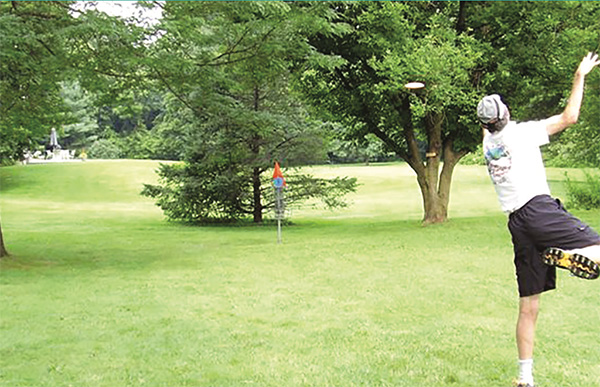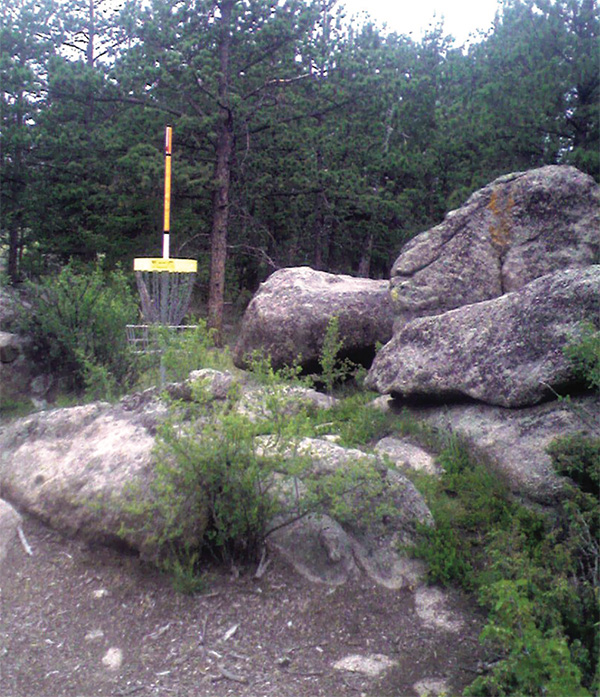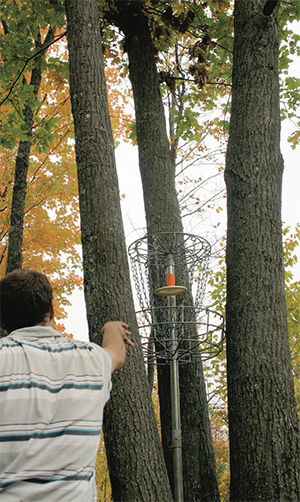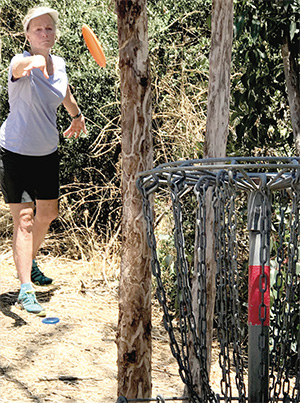Is Putting Really Too Easy?

This article originally appeared in the Fall 2019 issue of DiscGolfer Magazine.
Over recent years, there has been continuing talk that disc golf putting is too easy. Of course, many of us would say, “You’ve got to be kidding! If I could putt, I’d be good!” So, is putting too easy or isn’t it? More specifically, if there really is a problem, what is it, exactly?
It seems as if almost all players, regardless of skill level, would say that putting is a continuing challenge. Of course the nature of that challenge differs with skill. Novices struggle to consistently hit five-meter putts and top pros find the same level of challenge from 15 or 20. So, what’s the problem? That sounds like just about as it should be, right? We would expect to find the same pattern in basketball, archery or bolf — that’s what I like to call golf with a ball. Greater distance equals greater difficulty, but all players find their level of challenge. So, why does this issue keep coming up?
Let’s put ourselves in the role of a promoter of the game. This position can offer a very different point of view from that of a player. A player’s challenge is straightforward — complete the course in the fewest possible number of throws. That’s it. Do that better than others and you’re good. That’s not to say that some players don’t also see other perspectives, but their competitive success is dependent upon that much more simple goal.
So, what’s our promoter seeing that might raise concerns about putting? Let’s look in on a final round of play in a pro tournament. A gallery surrounds the tee and stretches down both sides of the fairway. We are in luck — it’s the top card and all four players are within a throw of the lead with just three more holes to play. This is a good as it gets and the crowd has that special buzz that we all love. They are seeing the game at its very best. The players throw their tee shots, each with a somewhat different route, but all in good position for approach shots around a sharply curving fairway that rises to the green. The crowd surges up the fairway and the course marshals have to really hustle to keep a path open for the players and establish a gallery line behind the approach shots.

Spectator Walk-off Layout
Three of the four players put their approach shots inside the 10-meter circle, with one straying off to the edge of the woods about 40 meters short. After the shots, the crowd again rushes forward, setting up behind the player on the edge of the woods. He pitches up to the green, parking under the basket. And as we promoters watch, what do you think the crowd does next? All the players are on the green, with putts from one to seven meters in length. Based on my experience in such situations, here’s my guess: as the players approach their putts, the crowd flows around the green and on to the next tee and fairway. The marshals have to struggle to have them not disturb the completion of the hole. Hmmm. What have the fans just told us? Even though they are keen to see how this battle sorts out, they have voted with their feet that there is nothing more to see here. Although there are four more throws to be made, the fans have decided that this hole is over.

Don't be long here! | Credit: Bill Wright
So, as we watch this unfold, as promoters or game designers, is it a big deal? A reason for concern? Well, as a bit of an experimental comparison, let’s change the scene to the US Open Bolf Championship, trying to keep the situation as similar as possible. Score tied, players on the green, three more to play. Any fans leaving the green? Nope, not one. Nobody wants to miss such a critical shot that could determine the championship. This is a very, very big difference, which may help us focus in more accurately on the nature of this problem, if there actually is one.
But, before we leave the bolf green, let’s think a bit more about why the completion of their hole is so much more compelling than ours. Just as a quick sidebar, as I’ve written before, I do think that disc golf holds up very well against its older cousin in most other facets. All in all, I believe that our version of golf is more telegenic for lots of reasons. For one, our strategic choices are more obvious and intriguing. It’s pretty easy to follow the thought process of a disc golfer who usually has many more strategic options to answer a course problem. The choice of a high, curving flight or a precise roller between the trees or a multiple-skipping ground shot are all easily seen and understood. And, of course, there also is the choice of discs and deliveries. There simply are many fewer options available to the bolfer. This dramatic difference also makes it much easier to build star players as their personal style and character is so much more available and intriguing. Sure, I’m a little prejudiced on this, but I’ve watched and played a lot of both games. We are simply more interesting … except on the green. What’s so fascinating about hitting a ball into a hole? Well, several things contribute:
- Even short putts are easily missed. It happens all the time, even to the best.
- Greens are often devilishly tricky, with rolling contours that make for dramatically curving putts. We like to watch things curve.
- And the visual setting is wonderful. The green is … green. Seeing that brilliant white ball curving across the green is very, very cool. On every telecast we see a chip or putt trace a dramatically curving route. And then — the big finish — at the last instant, they magically make the ball disappear. That is great TV!
So, what do we do? Just admit that bolf holes end more dramatically than ours do? Well, let’s see.

A rocky green at Sundance Trail Ranch on Red Feather Lake. | Credit: Christopher Thomas
The most common reaction to the “too easy” concern has been a seemingly reasonable one. If our putting is too easy, then let’s make it harder. The obvious result is a less-receptive target. Just make the hit area smaller. Smaller hit area definitely equals higher difficulty, fewer successful putts and smaller range of putting certainty for all levels of players. Or, maybe even a smaller basket that is mounted on the top of the current basket, just for the pros. Of course, unless it’s some sort of retrofit, this requires a good bit of new equipment. Either way, that’s a negative, but maybe a tolerable one if it fixes our problem. But, does it? What would be the expected results? Do our fans now stay at the green?
Let’s start a bit further back with some other unintended consequences. How about holes-in-one? Virtually all of our SportsCenter Top 10 shots have been aces. Obviously, with a less-receptive target we would have fewer of those. Let’s agree that everybody loves aces. And, nobody says that they are too easy. But, we wouldn’t only be giving up some aces. The more difficult target also figures to reduce the number of long approach shots and putts that go in for us now. How many fewer? Who knows? But there will definitely be fewer. And, these long, successful shots are a huge asset to the game. Think about Philo’s now internet-legendary albatross from the 2016 Beaver State Fling.
Does it go into the tougher target? Maybe, but maybe not, and if not, his epic, mind bending shot turns into a close, but not quite, non-event. The same is true of virtually all of our best memories of the game, both as players and as spectators — a big, big loss.
But, back to the intended benefit of the more difficult target. Does it make our green play more compelling? One key factor holding bolf spectators at the green was the possibility that shots will change hands — short putts may be missed. Well, that’s probably the case. More, and shorter, putts may be missed. But, is the putting more compelling? I would guess that it’s not. The “gimme” distance is reduced and the made putts are shorter. Players will adapt and be more likely to lay up and tap in, which is a singularly uninteresting way to end a hole.
So, if the more difficult basket isn’t the answer, what is? Is there any reasonable way to make our finish of hole play more intriguing and challenging, a better match to the rest of our game? I feel pretty certain that there is. And, I wish that it was more earth shattering and patentable. But, it’s pretty simple and we already have the components in place. I believe that we just haven’t taken sufficient advantage of them. I don’t think that there is anything basically wrong with our baskets or that putting is too easy.
I believe that the problems that get grouped under this concern stem from the fact that too many of our greens are just not sufficiently challenging. This situation has developed through some traditions of design and a continuing theory that at the end of a challenging fairway, we owe the player an unencumbered foul shot at the basket — an open green, with 360 degree access to the target. It’s an understandable point of view. Hey, the dude busted his tail to get up here. The least that we can do is welcome him home. It makes perfect sense, especially when seen from the single-minded perspective of the player striving for consistently lower scores. Who needs more problems to solve?
But this is the key point in all this. The promoter/game designer viewpoint needs to deal with these broader concerns. The player’s motivation to complete the course in the lowest possible number of throws is a given. The goal of the broader perspective is to have the game be as interesting and challenging as possible to play and to watch. There are other goals and practical restraints of course, like fairness, feasibility and sustainability, but unless the game is sufficiently interesting and challenging, it probably goes away.
That said, what I’m suggesting here is a small, but I believe significant, tweak in our design practice. This is a dial to be turned, not a switch to be flipped. We already have lots of holes that have interesting, challenging greens. It’s just that we apparently don’t have enough of them or we wouldn’t have this continuing talk that putting is too easy.
That’s the essential point here. Our putting is fine; our greens are too easy (boring). In contrast to that limitation, I suggest that we can improve our game by having more greens that include challenging features. Those features, on or near the green, provide several kinds of benefits.

Woodland greens at Highbridge hole 17. | Credit: Chuck Kennedy
So, with that in mind, let’s return to our exciting disc golf pro championship final round and back up the video to the tee shots. In our earlier scenario, all four players seemed to be in good position off the tee. They were all in the open and could see the unencumbered green. But let’s change the green a bit. Now, there are four sentinel trees trapping the right side of the basket. They are mature trunks spaced about 50 cm apart and two meters from the target. This situation creates an entirely different thought process for our pros. In fact, they are now looking at the green in a way very similar to how Bubba sees a green that he is approaching at Augusta. His caddy book shows him that the left front of the green provides a friendly path for his birdie putt. He also knows that the right half of the green has a notoriously tricky contour that rarely yields to a single putt. Landing on the back third of the putting surface will almost certainly result in a roll off into the cool waters of Rae’s Creek.
Wow! This shot is a big deal. Critical shots can change hands. And the addition of these four traps has now put our disc golfers in an almost identical situation. What was previously a routine (and less interesting) shot up to pretty much anywhere on the green has now become a critical placement, demanding their full attention. So, let’s play it out. Our one player still hooks his shot into the edge of the fairway on the right. One player lands on the left edge of the green an open path to the basket as before, but a bit longer as he is wary of straying to the right. The other two players take a more aggressive route and end up on the challenging right side of the green.
Our guy back on the edge of the fairway now has an even more demanding shot because he has to get himself a decent putt or he may fall two behind the pace. Rising to the challenge, he punches a roller out of the bushes. It skirts the left side of the trapping trees and curls safely around the basket. The clever effectiveness of the shot earns a cheer from the crowd. But, there is still a good bit of work to be done by the others. The gallery gathers up close to see how it plays out. Our fellow at the left edge of the green lines up his 12-meter putt and rams it in.
Next, we move to the two considerably shorter putts, but now nobody is departing for the next tee. Just like at Augusta, these shorter putts are far from certain. People have their cameras out. The player who’s away has a few choices. He can stretch far to his left and try a sharply-curved, lefty sidearm, or take the same route with a righty backhand that would float a bit higher and then stall, diving onto the tray. He looks at both of those and then stretches first to assess going to his right, which offers a more direct path but a narrower opening between the trees. That route also requires that he go over a chest-high limb. The path to the chains is perfectly clear, but the throw must be precisely on target. He looks at each option as the gallery close behind him makes their own assessment. He settles on the lefty sidearm; lines it up and flicks the delicate shot into the air. As videos roll, the disc slices around the tree and into the chains. The gallery erupts in response, rewarding his virtuosity, marveling at the finesse he has shown with his off hand.

Spectator Bonus Layout
The next putter, farther to the right, has fewer options. His only promising route is the tighter one, between the trees and over the limb. Again, the path is clear, but narrow. He tosses cleanly through the opening, but the horizontal limb has distracted him into a small over adjustment and he hits the chains just a bit too high and the disc slides off to the right. The crowd groans in sympathy and applauds his effort. And then, with the action complete, the gallery hustles for position at the next tee, ignoring the two remaining drop ins.
This seems to me to be a dramatic difference that significantly increases the intrigue of our putting game. Both examples are pretty typical of what can be expected. The one situation is simply more intriguing than the other. The short putts have gone from perfunctory acts of no interest to video highlights. That’s a pretty good upgrade. Is it more demanding of the players? Absolutely. We’re now requiring that they extend their creativity and skill set to the completion of the hole. No more routine putts, unless you earn them. That’s an important element to remember. If these more challenging greens are designed as I suggest, an excellent approach shot will still be rewarded with an unencumbered putting path. And, ideally, as in our example, even an approach shot that is not in the optimal position should still offer some putting solution, though it may be more difficult. Good courses should exact costs for less than excellent shots and this should be true from tee to basket. To require less diminishes the potential and appeal of our game. As JFK once said about disc golf (I believe), “We don’t play because it is easy, but rather we play because it is hard.”

Beth Verish gets tricky to sink this putt. | Credit: Stork
A few practical considerations:
More challenging greens can be achieved in many different ways, but there are a few important principles: It should be done with objects that are durable — bushes don’t work well. Players eventually trample them down. The best traps are such things as well-established tree trunks and large branches. Some courses are blessed with interesting geological formations. Make use of those. Buildings can work as well. But, this brings us to the issue of constructed structures. I know that some folks simply hate such encumbrances, dismissing them as “Mickey Mouse.” I’ve never really understood that reference. (I mean he’s the single most popular and successful rodent in the world. Why is that a put down?) Anyway, I still know what you mean. I guess that I’m just not that much of a purist. Sure, I love a sturdy stand of trees as much as the next designer, but if it’s the only solution to an otherwise boring green, I’ll take an esthetically pleasing and well-designed structure for sure. Make it out of natural materials if you have such sensibilities. Let’s face it, our target is a pretty industrial intrusion in a sylvan setting. Just sayin’ …
In closing, a couple of takeaways: I hope that you’ve not been disappointed by the simplicity of these suggestions. I admit that there is nothing brand new here, but that’s part of the appeal. We already have lots of holes just like the more challenging greens that I describe. I’m simply suggesting that such greens should be much more common and that if they were, we would have a significantly more interesting and challenging game. We could also stop talking about the non-issue of too-easy putting and the various other complex and potentially harmful solutions to that non-problem.
So, if you agree or you’d simply like to try a low-risk experiment to see if this idea plays out as described, simply lobby to make the necessary adjustments on some of the greens at your course, even on a temporary basis. Then, just see how they play. I’m pretty sure that you’ll be pleased. And, as a result, we’ll have a better game, one hole at a time.
